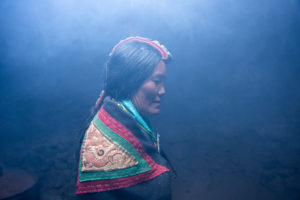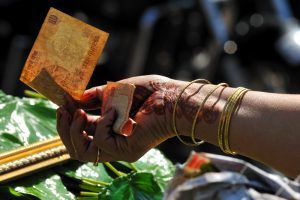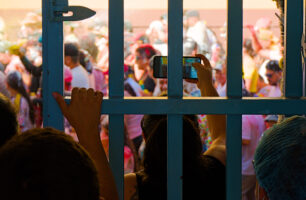Support Hidden Compass
Our articles are crafted by humans (not generative AI). Support Team Human with a contribution!
Still half asleep, my eyes adjusted to the glare of fluorescent lights in Cancun airport — a harsh contrast to the soft moonlight of the early morning sky outside. Joining the long baggage drop queue, I notice the stream of identical black duffel bags running alongside the zigzag of people waiting to board the flight to Cuba. Each person ahead has three or four bags stacked beside them, and those joining behind me have matching bags slung over their shoulders.
There isn’t another tourist in sight, I realize, as I add my backpack to the lines of luggage.
For years, I have poured over colorful, contrasting photographs of Cuba. They are saturated with classic cars and a bright mismatch of architecture against sizzling skies, capturing men gathered on streets ablaze with the low orange sun, and molten embers from thick cigars glowing under straw hats.
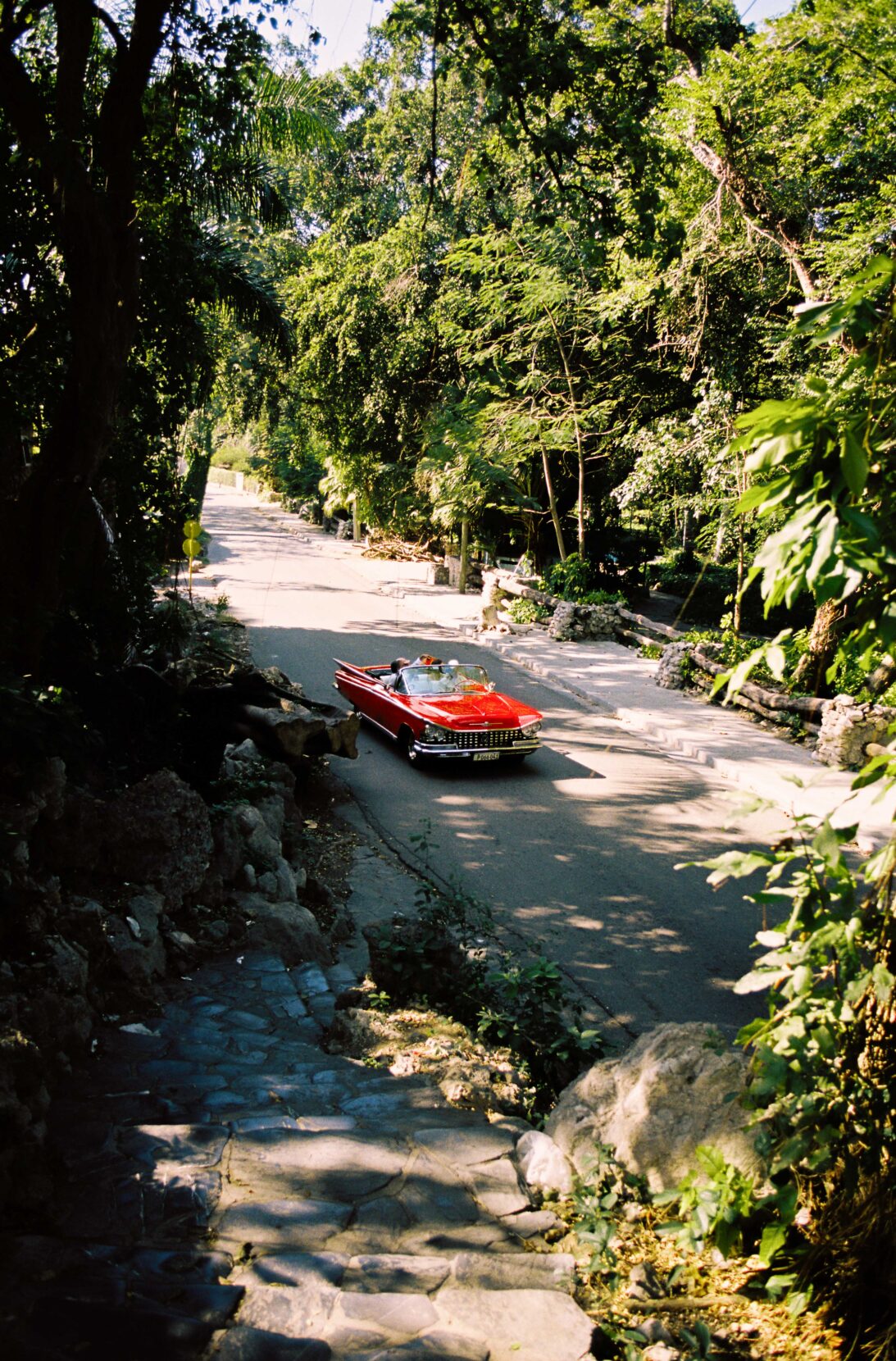
Enticing, classic photos of Cuba, have drawn photographer and writer Ella Calland to the Caribbean nation for years. Photo: Ella Calland.
Those images captivated me with their cinematic representation of Cuban life. Now, I was ready to walk into the postcard — to zoom in on the 1950s film set those classic images evoked.
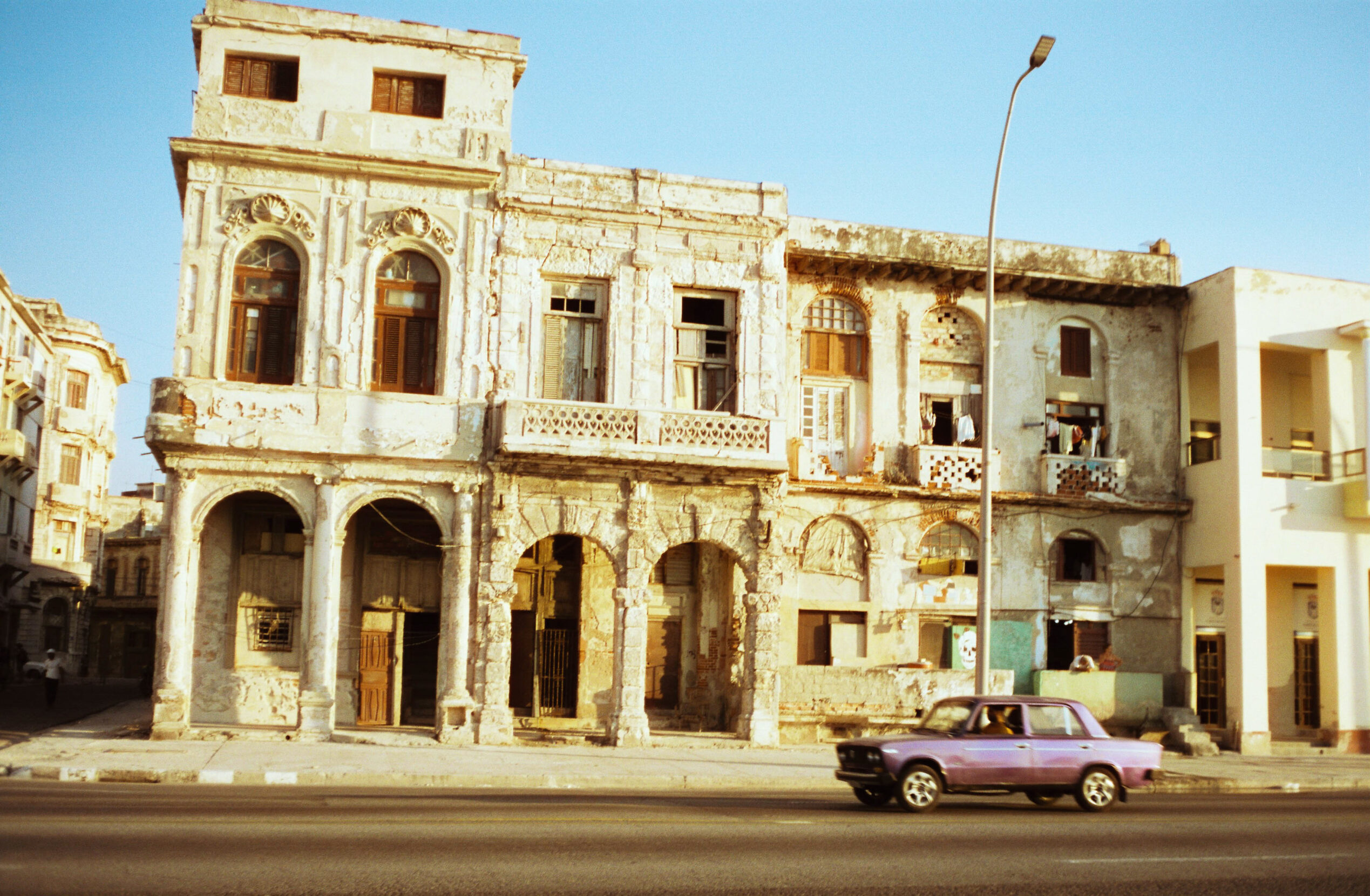
As she walks along the Malecón — a stone waterfront esplanade or embankment — the author catches grand architecture and modern movement in Cuba’s streets. Photo: Ella Calland.
As we all wait to board, I am whisked out of line and fast-tracked to the front, my eyes wide with the promise of a Cuban adventure.

A taxi driver smokes a cigar in his immaculately cared for car — a memory of a bygone era. Photo: Ella Calland.
~~
In Havana, the pastel hues of towering colonial-style buildings blur into my beaming reflection in the rose-tinted car window. Skin sticking to the faded leather seats of the old American taxi, I am transfixed by the passing sights: a rainbow of neoclassical pillars and balconies rising up from the busy traffic on the shaded roads below.
As we pull up to Plaza Vieja, the square drenched in morning light, I am surrounded by baroque buildings with grand, circular archways casting long, curvy shadows along the tiles. The air is thick with car fumes and sea salt, melodic Afro-Cuban jazz drifting down the promenade of cafes. I have arrived.
The band plays on, the flick of a drumstick and a flash of the pianist’s face coming in and out of view in the beacons of light.
Beyond the clusters of tables and chairs, my host greets me in a breezy, sky-blue shirt below the lemon-hued arches of the Airbnb. As he shows me around the mezzanine apartment with its spiraling iron staircases, the gleaming promise of three weeks in Cuba stretch out before me.
He sits down to lay out the tourist necessities, handing over a map of Havana before finally getting to the matter of cash.
“How many dollars do you have?” he asks.
Our conversation slips between English and my broken Spanish as I explain I do not have many United States dollars on hand. The look on my host’s face leaves me uneasy as I walk him through my plans.
“You’re here for three weeks?” Disbelief is mixed with a hint of dismay in his voice.
Unimpressed with the limited dollars in my pocket, he gives me 140 Cuban pesos (CUP) per dollar, generous compared to the bank’s 120 pesos, and wishes me luck.
Even still, I burn through my cash in Plaza Vieja.
Fueled by rum and rumba echoing through the streets, the energy of Havana seeps under my skin. On this first night, I leave my camera at the apartment, keen to immerse myself in the carefree spirit I imagine in every musical note, salsa spin, and puff of cigar smoke. To capture this energy, I need to live it first.
Perched in a local bar, watching old cars and horse-drawn carts trail over the vintage cobbled streets, I am sure my host’s worries are misplaced — I’m not out of my depth. I have dived headfirst into the Cuban dream.
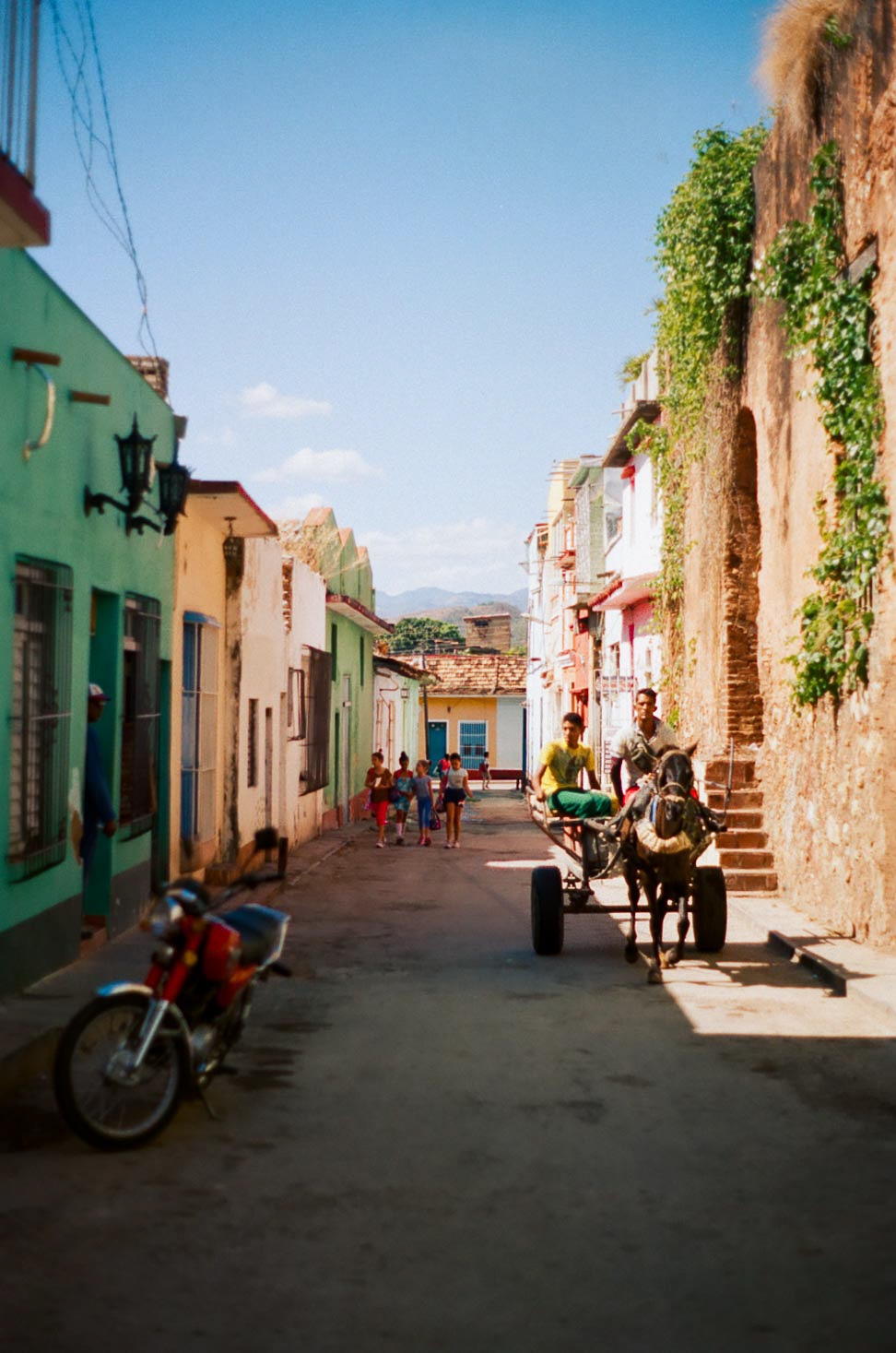
In Cuba’s towns, transportation blends the old-fashioned and the modern with motorcycles, cars, and horse-drawn carriages. Photo: Ella Calland.
~~
In stark sunlight the next day, my head pounding from countless daiquiris the night before, I venture out of the hotel district and into the residential depths of Cayo Hueso. Wandering just a few streets outside of Plaza Vieja, the airy Spanish squares narrow into crowded neighborhoods, and strung-up laundry casts snaking shadows which darken front doors and stretches of sidewalk.
In the faded grandeur of these suburban streets, the idyllic image from my postcard begins to fray. Walking among lofty, crumbling colonial buildings, I smell the stench of sewage and take in the garbage bags and animal carcasses that lay rotting on the ground.
But amongst this dilapidation, tucked away from the dressed-up tourist district, is the bustling life of Old Havana — a community that spills out onto the street. Golden light catches the edges of neighbors’ faces as they lean out of windows to catch up with each other. Men huddle around tiny tables, playing endless games of dominos.
This is different from the photos I’ve spent years marveling over. The revelry is here in Cayo Hueso, to be sure, but the carefree feeling I had imagined is missing. As I walk down the ramshackle roads, sidestepping upturned concrete and broken cobblestones, introductions and welcomes quickly turn to requests for money.
While the tourist streets are lined with souvenir shops packed with cigar-shaped magnets and Che Guevara T-shirts, groceries in the neighborhoods are hard to come by. Every month, each Cuban citizen receives a small package of rice, beans, toiletries, and other basic items from the government, but according to a 2023 Cuban Observatory for Human Rights (OCDH) report, it is nowhere near enough to survive.
Passing through Old Havana’s faded shopping district, I see sidewalks blocked with long lines outside bare shop windows. People waiting for hours to get their hands on cans of chickpeas, mothers waiting to get powdered milk for their babies.
Of course, this scarcity is also an opportunity for some. In the residential streets, unauthorized vendors set up illicit shops in the front rooms of their homes — the shadow market both combats the problem and exacerbates it.
Each bootleg store is unique, selling a handful of products, from fizzy drinks to tampons. The bounty on offer depends on what sellers could find on their trips overseas — hence the piles of duffel bags at Cancun airport, I realize.

Beneath an apartment building in Cayo Hueso, trash piles up on the sidewalk. Photo: Ella Calland.
~~
In Cayo Hueso, I stay in a casa particular — a term for the system allowing residents to rent their spare rooms to Cuba’s tourists. The house, narrow and baby blue behind white wrought iron gates, is owned by a woman named Yany.
Wearing dark denim shorts embroidered with silver stars, hooped earrings, and a cotton-candy colored crop top, Yany is spirited and outgoing, brimming with friendliness.
Living with her dog, which she calls Niño, Yany seems to relish opening her home to tourists visiting Havana.
“For me it is the best job I ever had. Even though each person is different, I can deal with them because I see it as a way to have interaction with different cultures and generating a little more income.”
Choosing casas particulares over hotels means putting money straight into the pockets of the hosts, rather than the government. Earning between $10 and $30 dollars per night is a huge influx of cash when the average wage for Cubans is $15 a month, and the highest-earning doctors only take home around $140 a month.
On my first night in Yany’s home, I sit with her among the beaded curtains and daffodil-covered Spanish tiles. Her house is a calm sanctuary away from the busy streets. As we share hot Cubita coffee and a home-cooked meal of beef strips, chickpeas, and rice, she runs through a list of the must-sees of her city, ensuring I hit all the right spots.
The air is thick with car fumes and sea salt, melodic Afro-Cuban jazz drifting down the promenade of cafes.
The days at Yany’s pass in a haze of strolls between the maze of Cayo Hueso and the wide high streets of Vedado. Walking along a curving stretch of the Malecón, I watch the pink and orange sunset-infused waves crash against the sea walls.
Yany’s recommendations send me to places like Fábrica De Arte Cubano, a cultural hub inside an old factory that showcases Cuba’s artists, and immerse me in the country’s modern music and art, unseen and unheard in Plaza Vieja.
The factory’s network of corridors is studded with doors to crowded DJ sets in pristine white rooms, photography exhibits displaying six-foot tall foot pictures, and live punk bands in an old style auditorium.
Many of her guests, Yany tells me, are shocked to discover what life is like in Havana, to discover the details left out of guidebooks.
“I say this because they tell me about it… [they are surprised] by the fact that we eat with a low salary and that despite the difficulties, we are always happy…” Yany says.
I have to admit that in this neighborhood, community appears to flourish. It feels almost old-fashioned to me: children playing outside from morning until night, and neighbors who seem tightly bonded.
But what is behind this unhurried daily life? Are the women and men leaning on the bars on the windows of their homes as happy as Yany says?
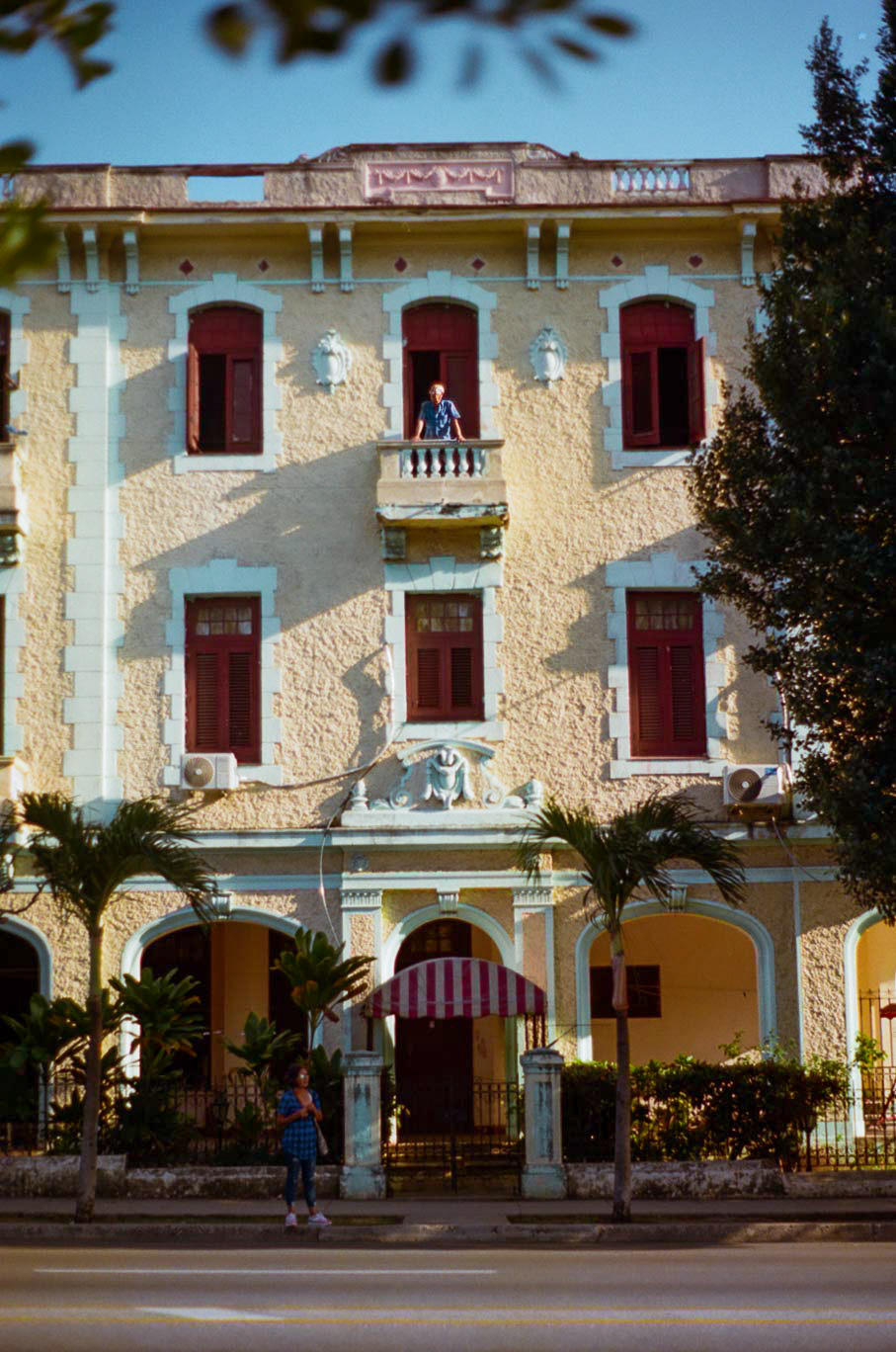
A man stands on his balcony in Vedado, looking out over his neighborhood. Photo: Ella Calland.
Following mass protests in July 2021, record numbers of Cuban citizens have fled the country. United States Customs and Border Protection reports that since October 1, 2021, more than 500,000 Cubans have arrived at U.S. ports of entry, most seeking asylum. That’s more than 5% of the nation’s population. The numbers are staggering — already outpacing the number of Cuban citizens who arrived in the U.S. during the Freedom Flights in the 1960s, the Mariel Boatlift in 1980, and the Balsero crisis in 1994 combined. At a trendy cocktail bar in La Rampa, a young bartender tells me he works seven days a week now because all his friends have gone overseas, and there’s no one left to see in his free time.
Sharing plantain in Yany’s home, it starts to feel like I am taking limited resources from an island struggling to supply its people. During the week I stay in Havana, there’s a toilet paper shortage. “For us, not for you,” Yany winks. The chasm between us grows wider.
~~
In the depths of a shadowy bunker beneath the pavements of Calle 23, a long, bustling commercial district, I am transported into a glowing speakeasy.
A tide of jazz thrusts from the stage to the back of the room as I pass the stretch of bar, giving a nod to the men nursing whatever rum-infused drink fills their Havana Club glasses.
Sitting at a table by the backdoor with a complimentary mojito in hand, I sink into the music. The melody ebbs and flows; soft bell-like piano and warm guitar reverb wash over the light and shadow that fill the jazz bar.
In the crash of a cymbal, a blackout plummets the room into complete darkness, cutting through my trance. Around me, a chorus of groaning sighs rang out.
Then, flashlights illuminated, one by one, creating little spotlights to enable the musicians to carry on playing and the barman to keep the drinks flowing.
The band plays on, the flick of a drumstick and a flash of the pianist’s face coming in and out of view in the beacons of light before the electricity buzzes back to life.
Back in the glow, the relief of the crowd injects a surge of energy into the performance, the rhythm roaring.
Sinking deeper and deeper into the moment, the sound of the jazz and my thoughts feel indistinguishable.
When another outage hits just ten minutes later, morale dips. For a few minutes, the drummer continues to play, pounding into the darkness. Then, the last splutters of music, before silence. The audience scatters, drinks abandoned, and the night is cut short.
I sit at the back of the room, finishing my drink in the dark, dazed from the whiplash of waking up mid-dream, as the last people trail up the stairs.
~~
As I walk down the ramshackle roads, sidestepping upturned concrete and broken cobblestones, introductions and welcomes quickly turn to requests for money.
In Havana, I played a key role in the economic endeavors of others. I ordered from separate menus with higher prices for tourists. I learned to look closely at my bills after one restaurant doubled it, hoping I wouldn’t notice. And I counted my change carefully after waiters gave me back less cash than I was due. It was frustrating, but I also understood it.
In 2021, the Cuban peso faced a sharp currency devaluation after Miguel Díaz-Canel, the current president, ended the dual currency system. Until then, Cuba had spent almost 20 years running on two currencies: the CUP, used to pay wages and utilities and acquire basic goods, and the USD-pegged CUC (Cuban Convertible Peso) for supplementary basic goods, luxury items, and other expenses. As a result of the switch and a multitude of economic factors — including the lack of farming technology, which prompts Cuba to import roughly 70-80% of its food — prices for basic goods skyrocketed.
When a taxi driver can make more money from a tourist in a single journey than the average Cuban citizen makes in a month, it creates an odd and problematic dynamic.
This partition between the tourist experience and local life is closely monitored by the state — the government runs a separate bus service for tourists, and casa particular hosts must register their guests with the government.
While waiting for a tourist bus in a room cordoned off from the rest of the station, I couldn’t help but feel unnerved. The postcard wasn’t just fraying, it was disintegrating.
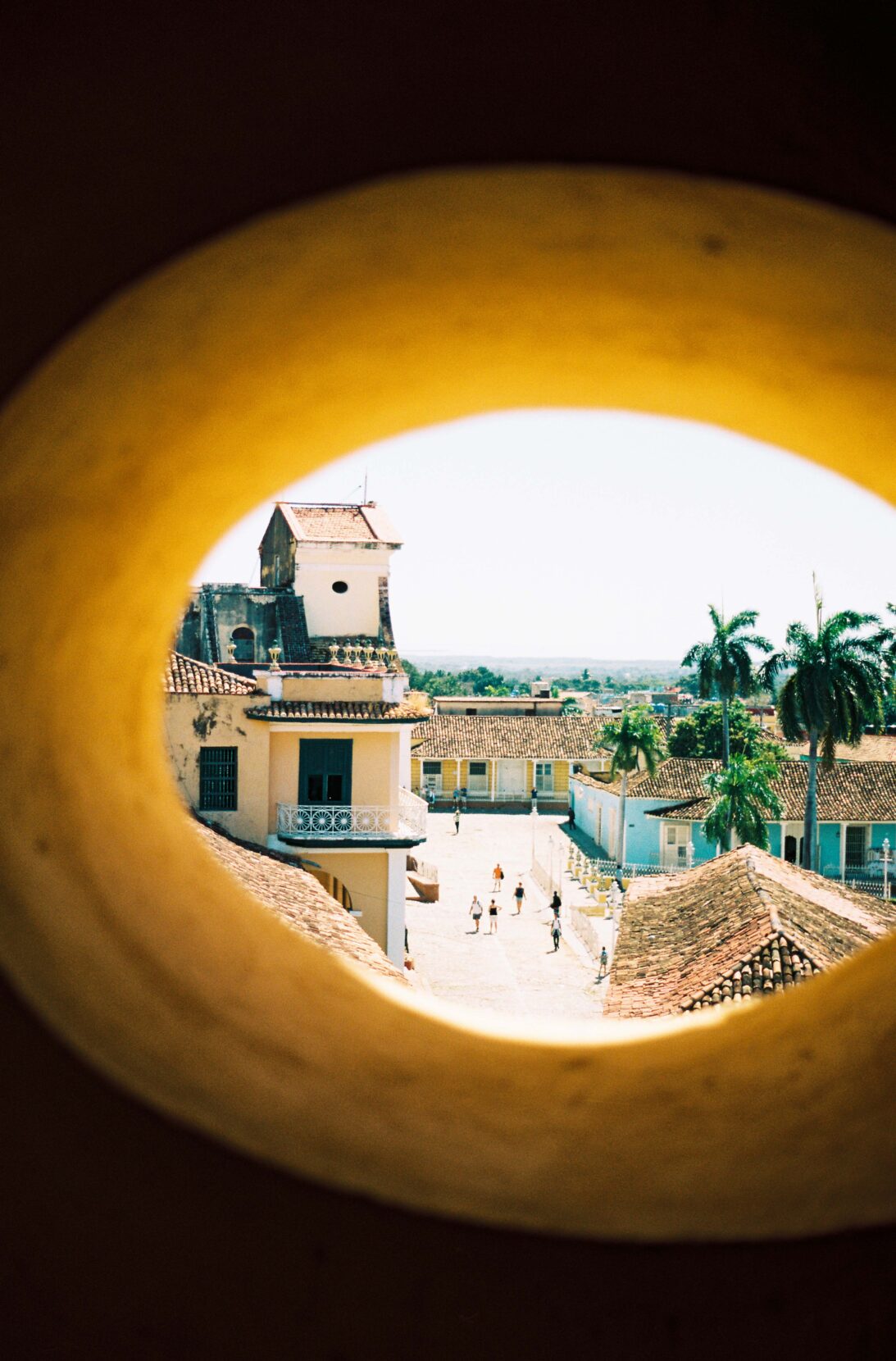
There’s only so deep a tourist can go. For Ella Calland, that feeling is captured in her photographs as well as in her words. Photo: Ella Calland.
~~
Three hours west of Havana, as I step off the bus in the town square of Viñales, I am met by a crowd of local women waving laminated images of their homes in the air, each desperate to rent out one of the brightly colored bungalows scattered along the valley.
I rent a bicycle from my homestay and spend the afternoon pedaling down the dirt roads below the lush limestone mogotes — dome-like outcrops, some of which are nearly 1,000 feet tall. I cruise through the cowboy town, the sound of clinking spurs and the clip-clop of horse hooves ringing through the air as men in wide-brimmed hats gallop past me toward the copper-colored tobacco fields. A lack of fertilizer, seeds and fuel in the country has limited farming in Cuba, meaning that only traditional tobacco and coffee farms can thrive in the fertile soil of Viñales’ micro-climate. Along with the fact that tobacco farmers are forced to sell 90% of their produce to the government, these restricted agricultural prospects have shifted the focus to tourism.
Rows of empty casas particulares, quaint restaurants, and souvenir shops give the village a toy town quality, a stage for cowboys to roam around selling horseback tours and their remaining 10% of tobacco to Cuba’s tourists.
From behind the camera lens, the scenes of cowboys staring off to the horizon from large wooden porches felt suspended in time, hanging in limbo between a past not yet faded away and an uncertain future.
As I reach out to shoot photos from across the divide, my position as a voyeur shrouds the present reality in doubt, making it impossible to grasp. I have the sense that these picturesque shots of an independent cowboy country have become a tourist facade, a smokescreen thinly veiling a society in desperate need of the cash flow of tourism to survive.
Driving toward the town of Cienfuegos, the mossy green limestone mounds shrink in the rear window of the car. Viñales slips into obscurity.

A man gazes out over the fertile land, perhaps lost in a daydream. Photo: Ella Calland.
~~
Two hundred fifty-seven miles away in the coastal town of Cienfuegos, an effortlessly cool man in a low-collared powder-blue shirt and silver lens shades leads me through his sun-dappled botanical garden to a cozy, red-roofed guesthouse that will be my home for the next two nights.
Keen to share a cup of his signature strong-brewed coffee, I sit with Ricardo among the hanging plants of his terracotta patio as he speaks with equal parts pride and bitterness about his country.
With a gleaming excitement in his sun-crinkled eyes, Ricardo asserts that Cienfuegos is the best city in Cuba. It doesn’t take long for me to agree with him: the well-preserved historic center, neoclassical colonial square, and old Hollywood high street make Cienfuegos a photographer’s dream.
I stroll for hours among these whimsical relics, drifting down toward the bay, the streets evoking a sedated American fifties suburbia, with peppermint painted condos lining the harbour and vintage Chevrolet Bel Airs sitting shaded by the trees, their fins glinting in the afternoon light.
Despite the early hour, friends drink together in the pristine white yacht clubs that sit along the promenade, and local families gather beneath the glaring red and silver metal domes of an outdoor diner complex.
I decide to follow the eerie sound of muffled music blasting across the harbor, which takes me to an imposing pine green and white striped baseball stadium. Inside the empty arena, craning lights tower above me, and a scoreboard scribed with a retro font read “Estadio 5 de Septiembre,” a nod to the naval uprising in Cienfuegos in 1957.
Every view is a cinematic delight steeped in history; the pristine hues of Cienfuegos twinkle by the sea. Life here looks dazzling, and I want to capture it all.
Returning to Ricardo’s home just before sundown, we share stories from the day. While I spent my hours soaking up Cienfuegos’s charm, Ricardo had waited in a line all afternoon just to get his hands on a couple of screws.
His frustration at the current state of Cuba is palpable, and at once I feel my adventures of the day are out of step with the realities of living in Cienfuegos.
“Life has changed a lot for everyone. We face a depressed economy with great inflation … and, above all, the lack of freedom to be able to choose our opinion and the life we wish to have.”
The current economic crisis in Cuba severely impacts people’s enjoyment of social and economic rights. In August 2022, the Inter-American Commission on Human Rights said that Cubans were suffering a “collapse of the public healthcare system” and a “widespread rise in poverty and inequality.”
Ricardo tells me that staying with locals is the only way to truly see Cuba through a local’s perspective. “As hosts we are able to teach our culture, our idiosyncrasies, the reality that we live in at home, not through hotels, which sell an image that the Cuban people do not live.”
The pastel hues of towering colonial-style buildings blur into my beaming reflection in the rose-tinted car window.
The view from Cuba’s hotel districts minimizes and distills a rich and complicated culture and community into a picturesque postcard — one I’d believed over and over for years. But why had I believed it? I’ve traveled enough to know places aren’t postcards. They are always more complex than the world perceives them to be, and yet, when it comes to Cuba, so many of us are still ready to believe the curated snapshots.
By engaging with my hosts and others, I found a more nuanced window into Cuba, but as an outsider there was only so far I could go.
In a land that seemed soaked in nostalgia, at times, it felt like I was walking through a memory that didn’t belong to me.
~~
The final leg of my trip takes me to Varadero, a narrow 12-and-a-half-mile splinter of coastline stretching out from the main island, surrounded by turquoise waters.
The promise of days spent at the edge of a glistening ocean is shaded with unease after a Canadian, who had moved to Trinidad, Cuba, nine years before, warned me that if I was staying in the residential district, I should eat early — before the food ran out.
His cautions are warranted. Menus, once five pages long, now have only two meals on offer. The government shop in the town center stocks minimal products, its shelves lined with chopped tomatoes, off-brand cola, and the familiar canned chickpeas.
But this scarcity doesn’t seem to impact the all-inclusive hotels that dominate the far end of Varadero. Wandering the beach resorts, I see hotel shops packed with branded goods like Pringles and Haribo candy — items unseen on the rest of the island.
Each resort claims a slice of the beautiful beach for itself, reserved only for its guests, and offers an all-day menu that never runs out.

Through the trees, we catch a glimpse of a beach in Varadero. The resort town is home to turquoise waters and sandy beaches, many of which are reserved only for hotel guests. Photo: Ella Calland.
Watching the shiny Oldsmobiles whisk hotel dwellers on swift tours around Varadero, I think back to the Lonely Planet headline, “puff on Cuban cigars or cruise down the Havana streets in a classic car for a true taste of the good life.” This ideal displayed to Cuba’s tourists isn’t reality. It’s a blurred view from a rose-tinted car window.
Later, walking through the residential blocks, I stumble upon garden parties alive with music, neighbors entwined in dance. On the public stretch of beach, families lay on the sand watching the sun go down, and couples take turns sipping Havana rum from the bottle.
Amongst faded dreams, broken colonial promises, and remnants of revolution, Cuba remains elusive — remarkable yet troubled.
I think about my rolls of film — my attempts to capture this place in images. I imagine each frame of the roll flitting past me, projecting a kaleidoscopic view of Cuban life from the eyes of a traveler. A montage of images sliding between intimate and distant points of view, coming in and out of focus.
As the sun sinks into the glittering sea on my last evening in Varadero, I click a photograph of the silhouetted figures against the fiery sunset — the moment captured in my hands and slipping through my fingers at the same time.
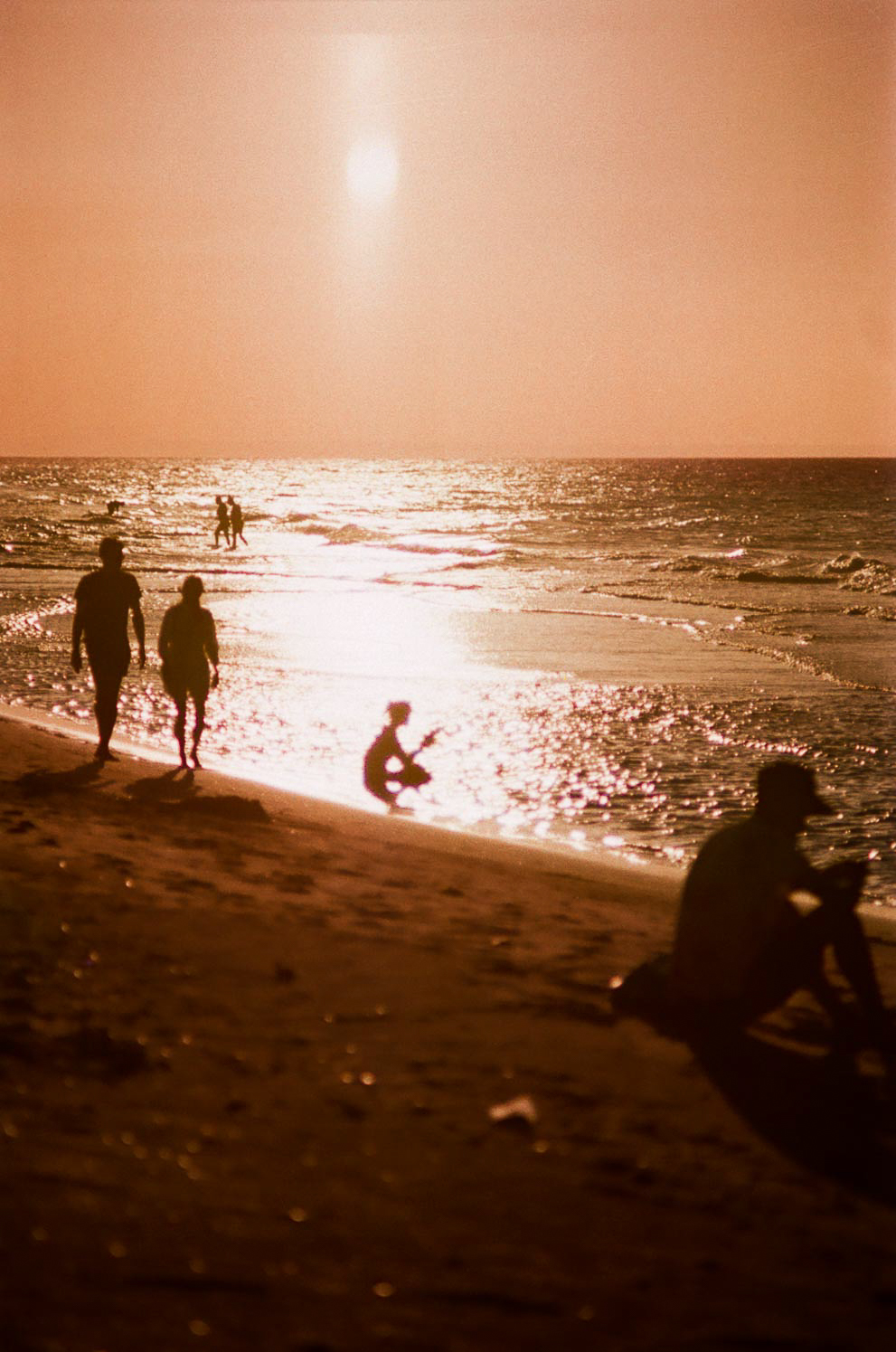
While much of the Varadero coastline is reserved for Cuba’s tourists, on a public beach, locals take in the view as the sun sets beneath a fleeting, fiery sky. Photo: Ella Calland.
*Some of the names of sources for this story have been changed to protect their identities.
Ella Calland
Bristol-based writer and photographer Ella Calland’s passion for the power of stories has inspired her to document her trips around the world. Her 35mm photography seeks out the cinematic in the everyday.

